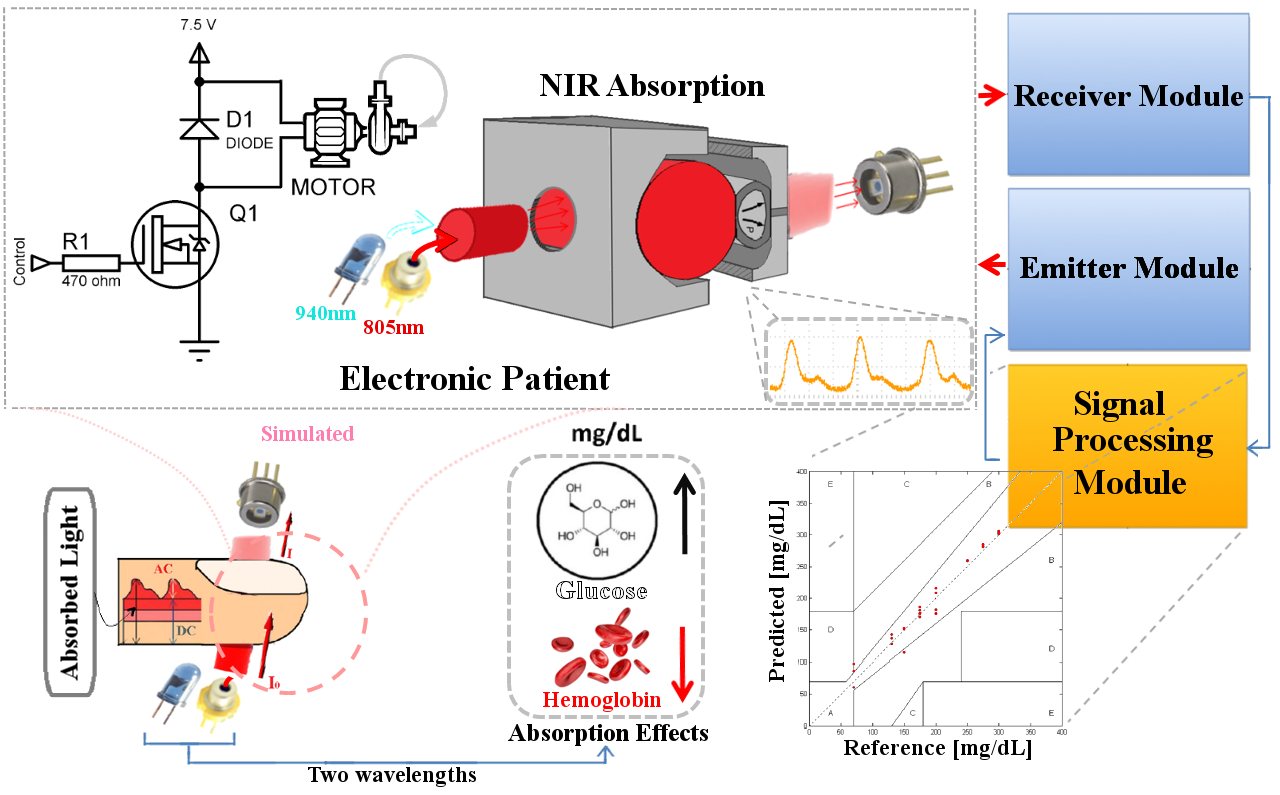A Non-Invasive Infrared Glucose Monitor Double Wavelength Based
Keywords:
Non-invasive, infrared, glucose monitor, eletronic patient, NIRAbstract
This paper presents the analysis and implementation of a non-invasive blood glucose monitor using a near infrared absorption technique. The architecture is composed by two light emitters, with a wavelength of 940 nm and 805 nm. Contrary to most of the systems presented in the literature, our prototype considers the absorptive influence of hemoglobins in the measure. The results were carried out in-vitro through a electronic patient that emulates the basic characteristics of absorption in biological tissues. The experimental results obtained from the prototype, verify the funcionality of the system and signal some of the advantages over the some of the state-of-the-art techniques.Downloads
References
BRASIL, “Caderno de atenc¸ ˜ao b´asica n 16-diabetes mellitus,” 2006.
P. B¨ohme, M. Floriot, M.-A. Sirveaux, D. Durain, O. Ziegler, P. Drouin, and B. Guerci, “Evolution of analytical performance in portable glucose meters in the last decade,” Diabetes care, vol. 26, no. 4, pp. 1170–1175, 2003.
J. L. Smith, “The pursuit of noninvasive glucose,” Hunting the deceitful Turkey, 2006.
J. Yadav, A. Rani, V. Singh, and B. M. Murari, “Prospects and limitations of non-invasive blood glucose monitoring using near-infrared spectroscopy,” Biomedical signal processing and control, vol. 18, pp. 214–227, 2015.
R. Castro J´unior, “Glicos´ımetro de pulso,” Ph.D. dissertation, Universidade de S˜ao Paulo, 2010. [Online]. Available: http://www.teses.usp.br/teses/disponiveis/3/3142/tde-16082010-161914/
S. C. Lam, J. W. Chung, K. L. Fan, and T. K. Wong, “Non-invasive blood glucose measurement by near infrared spectroscopy: Machine drift, time drift and physiological effect,” Journal of Spectroscopy, vol. 24, no. 6, pp. 629–639, 2010.
E. S. Julian, K. Prawiroredjo, and G. Tjahjadi, “The model of near infrared sensor output voltage as a function of glucose concentration in solution,” in 2017 15th International Conference on Quality in Research (QiR): International Symposium on Electrical and Computer Engineering. IEEE, 2017, pp. 146–149.
S. Haxha and J. Jhoja, “Optical based noninvasive glucose monitoring sensor prototype,” IEEE Photonics Journal, vol. 8, no. 6, pp. 1–11, 2016.
O. Amir, D. Weinstein, S. Zilberman, M. Less, D. Perl-Treves, H. Primack, A. Weinstein, E. Gabis, B. Fikhte, and A. Karasik, “Continuous noninvasive glucose monitoring technology based on “occlusion spectroscopy”,” 2007.
J. Yadav, A. Rani, V. Singh, and B. M. Murari, “Near-infrared led based non-invasive blood glucose sensor,” in 2014 International Conference on Signal Processing and Integrated Networks (SPIN). IEEE, 2014, pp. 591–594.
J. G. Webster, Design of pulse oximeters. CRC Press, 1997.
J. T. Moyle, Pulse oximetry. BMJ books, 2002.
P. Narkhede, S. Dhalwar, and B. Karthikeyan, “Nir based non-invasive blood glucose measurement,” Indian Journal of Science and Technology, vol. 9, no. 41, 2016.
Y. Mendelson and J. C. Kent, “Variations in optical absorption spectra of adult and fetal haemoglobins and its effect on pulse oximetry,” IEEE Transactions on Biomedical Engineering, vol. 36, no. 8, pp. 844–848, 1989.
I. Fine and A. Weinreb, “Multiple scattering effect in transmission pulse oximetry,” Medical and Biological Engineering and Computing, vol. 33, no. 5, pp. 709–712, 1995.
L. N. T. Nghia, “Design of a spo2 pulse oximeter phototype,” Ph.D. dissertation, International University HCMC, Vietnam, 2012.
Z. Xu, “Method and system for non-invasive optical blood glucose detection utilizing spectral data analysis,” Dec. 25 2012, uS Patent 8,340,738.
L. E. Frenzel, Eletrˆonica Moderna. McGrawHill Education, 2012.
N. S. N. Santos and S. M. S. Motoyam, “A large scale platform using wban technology for patient monitoring,” IEEE Latin America Transactions, vol. 16, no. 3, pp. 705–711, 2018.
C. C. Porto, Semiologia m´edica. Guanabara Koogan, 2009.
M. J. Hayes and P. R. Smith, “A new method for pulse oximetry possessing inherent insensitivity to artifact,” IEEE Transactions on Biomedical Engineering, vol. 48, no. 4, pp. 452–461, 2001.
J. P. Tello, O. Manjarres, M. Quijano, A. Blanco, F. Varona, and M. Manrique, “Remote monitoring system of ecg and human body temperature signals,” IEEE Latin America Transactions, vol. 11, no. 1, pp. 314–318, 2013.
R. Terzi, Monitorizac¸ ˜ao respirat´oria em UTI. S˜ao Paulo: Atheneu, 1998.
D. E. ISO, “15197: In vitro diagnostic test systems– requirements for blood glucose monitoring systems for self-testing in managing diabetes mellitus,” (ISO 15197:2003), 2003.
ISO, “9919: Medical electrical equipment – particular requirements for the basic safety and essential performance of pulse oximeter equipment for medical use,” (ISO 9919:2005), 2005.
W. L. Clarke, D. Cox, L. A. Gonder-Frederick, W. Carter, and S. L. Pohl, “Evaluating clinical accuracy of systems for self-monitoring of blood glucose,” Diabetes care, vol. 10, no. 5, pp. 622–628, 1987.
R. Rosenthal, L. Paynter, and L. Mackie, “Non-invasive measurement of blood glucose,” Jul. 2 1991, uS Patent 5,028,787. [Online]. Available: https://www.google.com/patents/US5028787


